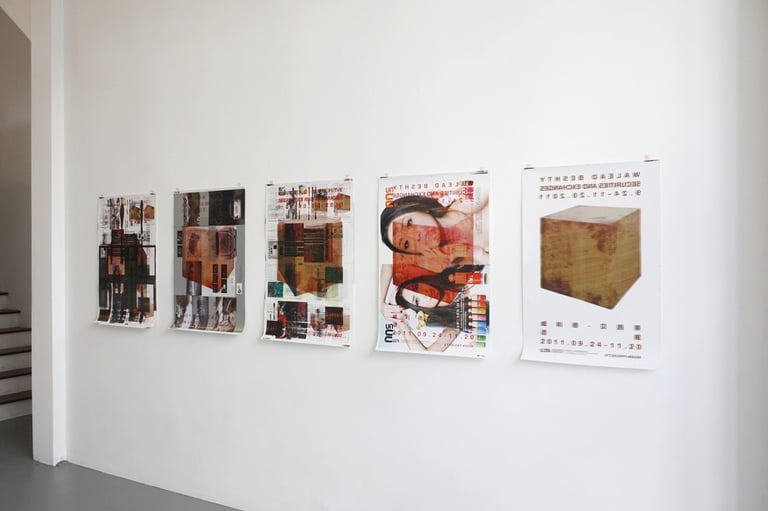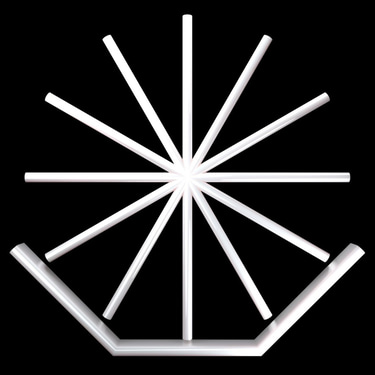In View of Affect: An Interview with Phil Chang
Christine Haroutounian
4/7/2012


Make Ready 3: Uncut Signatures (Walead Beshty: Securities and Exchanges, Ullens Center for Contemporary Art: Beijing, Jing Cai Shi Ji, Beijing, China, September 23rd 2011), 2011 by Walead Beshty. Image from Pepin Moore website.
“Affective Turns?” is the latest curatorial project organized by Los Angeles-based artist Phil Chang. Through the works of Walead Beshty, Justin Cole, Shannon Ebner, Owen Kydd, Sharon Lockhart, Erlea Maneros Zabala, Arthur Ou, Alexis Smith, Yanai Toister, Erika Vogt, and Jeff Wall, the exhibition brings to light the several meanings and functions of affect. Using various mediums ranging from sculpture, video, and photography, to works on paper, the show calls attention to the potentiality of affect entering sites of psychology, art, politics, performativity, and beyond. In this brief online interview, Chang shares details about his process of organizing the works and his larger examination of what drives affect. The show is on view at Pepin Moore in Chinatown from March 3rd to April 7th, 2012. For more information on the show click here.
Christine Haroutounian: You primarily work as a photographer; why did you decide
to organize an exhibition and do you feel that your background as an artist
specifically informs the way you curate? What does it mean to be a curator in a
society where social media outlets essentially allow everyone to “curate”
their identities and interests to the world?
Phil Chang: I organized “AffectiveTurns?” in order to have a group exhibition occur in tandem with my solo exhibition at LAXART. The idea was to have both exhibitions address my interest in affect, aesthetics, and economy. I decided to organize an exhibition (rather than “curate” one) in order to take responsibility for the conditions and type of practice that I’m familiar with. Since the incorrect use of the word “curate” is very recent, it reveals that ourculture longs for an organizational structure to be imposed on the overwhelming quantity of information and content that is pervasive today. It is laughable and troublesome when I encounter a curated selection of meats and cheeses, acurated selection of sneakers, or a curated line up at Coachella. We also stand to benefit from seeing the similarity in the way the word “modern” is misused to describe something contemporary. Dilution seems to be the metonymic solution to too much information while also seeking an overarching validation that curating somehow promises.
If we look carefully at the double standard that occurs with the present-day use
of “curate” then we can see through its shortcomings as well as the ideology
that supports it. Its misuse happens on two levels, that of activity and
language. There are cases of being more specific with one’s language that makes
the term function effectively. Eve Fowler’s and Lucas Michael’s Artist Curated
Projects has been an important initiative for artists and Los Angeles. Its
title and mission are successful – to support a community of artists –
precisely because they operate free of curatorial pretense.
It
seems to me that in our time – one of intense individualism, economic
uncertainty, abstract finance capital, and one of the digital – certain
activities are assumed to be adopted by those outside of that field precisely
because of the online fluidity of identity, activity, and practice. The critic
and curator Mary Leclere addresses these and other very relevant issues in her
compelling essay, “The Question of (e)quality: Art in the Age of Facebook.”
(X-Tra, Spring 2010, Volume 12 Number 3).
CH: How did you go about
organizing “Affective Turns?” Were there certain artists you were originally
interested in showing together or did the process grow more organically?
PC: I originally chose to include only photography since photographs have a specific way of addressing affect. One of these includes the referential nature of photographs and how it complicates intention and reception. The artists that I wanted in the show, however, also produced works other than photography. I realized that it would be interesting to see how non-photographic objects could also address the issue of affect. The process then organically developed.
CH: You refer to critic Stephen Shaviro in the exhibition press release, who distinguishes the difference between affect as how something is instead of what something is. Does this limit affect as something only to be subjectively understood, hence the open-ended exhibition title?
PC: The exhibition’s premise is about how artworks, though unavoidably reliant on affect, can also succeed at addressing the more affective conditions of contemporary culture and politics, while fortunately not having to be overt, didactic, or (no pun intended) affected. I was interested in how the works in the exhibition could raise the question of what degree of excess is at stake in how affect functions. Would that be meaning? Intention? Autonomy or contingency? Oblique or direct modes of communication?
Shaviro makes an interesting claim that moves us away from essentialist readings to that of function and utility. What his claim inspires is the importance of recognizing the relation between what a thing is and what it does. In this way, Walter Benn Michaels’ writings on photography, affect, and neoliberalism situate this question in a very useful and tactful approach to understanding the stakes surrounding not only art but also our current economic and political situation. (“Neoliberal Aesthetics: Fried, Rancière and the Form of the Photograph,” nonsite.org, January 25, 2011, Issue #1).
The exhibition’s title is intended to question the claim that affect is limited to subjective understanding and experience. The so-called “affective turn” is fascinating because it relies on a fallacy – that affect is fundamentally independent of intention and meaning because it is a corporeal process of the body – and one that makes it nearly parallel to some of the erroneous assumptions associated with photography – that the thing we typically invest in a photograph is in fact a property of the thing the photograph refers to. So, on one hand, what we are left with are certain affective and photographic turns that are indifferent to social, political, and cultural conditions, and on the other hand, we are given the opportunity to witness a crucial slippage. The misapplication of investment – in either the material body when it comes to affect, or the improperly imputed photograph that becomes confused with its subject matter – has the possibility of alerting us to the flawed way in which we think our feelings and attitudes have some relevance to social problems, namely economic inequality. In fact, its in a slippage such as this that we can be made aware of how autonomy can produce in what Michaels’ argues is “an art that’s more interested in being a counter-example than an example and less interested in representing the abuses of the system than in picturing the system itself.” (“The Beauty of a Social Problem,” The Brooklyn Rail, October 2011).
CH: You also mention in the press release how affect functions as “a perplexing condition that trades incliché and convention.” Can you talk about a piece in the show that particularly achieves this condition?
PC: Owen Kydd’s durational
photograph using video, “Canvas Leaves, Torso, and Lantern,” achieves this
through very careful consideration. Kydd’s work eloquently approaches
boundaries, reveals their locations (regardless of how useful that boundary may
or may not be), and produces a complex and important set of conditions. This
complexity involves a series of antagonisms between duration and inertia, the
precision of a pixel and the absence of any manufacturer logos on the monitor
display, and the inherent accumulation of frames within video and the loss of
any discernible beginning or end point to the work’s duration. His work
brings attention to how our culture’s obsession with “indexical-ish” images
(e.g. the popularity of Instagram and Hipstamatic apps) serve as an instance of
why the content of our works cannot only be articulated in the things that are
depicted but in the form of the work itself.
